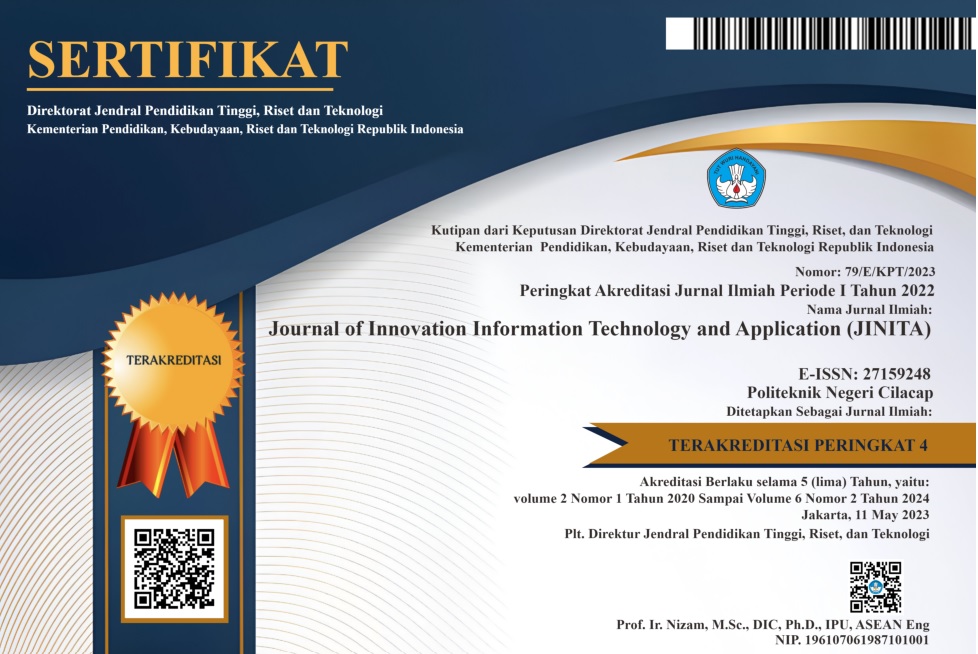Aplikasi Terintegrasi Registrasi Torche Education Menggunakan Framework Django
 Abstract views: 645
,
Abstract views: 645
,
 PDF downloads: 470
PDF downloads: 470
Abstract
The growth of frameworks for web application development is very rapid, especially on the back side (server) of web development or what is commonly called the backend. Several programming languages offer frameworks that have their own advantages, such as the Python programming language which offers a web application development framework, namely Django. It is equipped with the fast development, fast processing, and scalability. The data collection process was carried out by researching several related sources regarding the modules in the Django framework. The research process was carried out by finding sources of information about the Django framework to support the design of the Torche Education class registration application. Sources of information are collected to become a reference for application development. The Torche Education class registration application was built during the internship process at the company as it is concerned with developing the application according to predetermined working hours. It started by conducting research on the modules in the Django framework for developing registration applications and then followed by implementing the framework and integrating the application into several platforms such as Google Drive, Discord, and Gmail. Based on the application development above, the backend framework technology has been implemented in Python programming, namely Django. The results and benefits of the research can be useful for facilitating related parties in the process of recruiting students for class registration and making it easier for users to get fast information.
References
B. P. Zen, G. F. Fitriana, and M. A. Gustalika, “Peran Kompetensi melalui berfikir komputasi dalam membangun karir di dunia IT menuju Era Society 5.0,” Dedikasi Sains dan Teknologi, vol. 1, no. 2, pp. 94–98, Nov. 2021, doi: 10.47709/dst.v1i2.1122.
Y. Syafitri, R. Astika, and L. Rahayu, “PENGEMBANGAN APLIKASI PELELANGAN MENGGUNAKAN FRAMEWORK CODEIGNITER BERBASIS WEB,” Jurnal Informasi dan Komputer, vol. 10, pp. 1–7, Nov. 2022, doi: 10.35959/jik.v10i2.381.
H. Sabita, R. Herwanto, Y. Syafitri, and B. Prasetyo, “PENGEMBANGAN APLIKASI AKREDITASI PROGRAM STUDI BERBASIS FRAMEWORK DJANGO,” Jurnal Informatika, vol. 22, pp. 33–37, Nov. 2022, doi: 10.30873/ji.v22i1.3143.
H. Sabila, B. Praptono, and I. Arini, “PERANCANGAN APLIKASI PENCATATAN LAPORAN KEUANGAN DENGAN MENGGUNAKAN METODE AGILE DEVELOPMENT SCRUM,” JOISIE (Journal Of Information Systems And Informatics Engineering), vol. 5, pp. 67–74, Nov. 2021, doi: 10.35145/joisie.v5i2.1406.
Q. Sephira and E. Krisnanik, “Aplikasi Pendaftaran Kegiatan Program MBKM Menggunakan Framework Laravel,” Informatik : Jurnal Ilmu Komputer, vol. 17, p. 142, Nov. 2021, doi: 10.52958/iftk.v17i2.3630.
W. Priatna, “PENGARUH KEMATANGAN, KINERJA DAN PEMANFAATAN TEKNOLOGI INFORMASI TERHADAP IMPLEMENTASI SI DI SMK NEGERI JAKARTA TIMUR DENGAN MODEL COBIT FRAMEWORK,” Jurnal Sistem Informasi, vol. 8, p. 119, Nov. 2013, doi: 10.21609/jsi.v8i2.333.
S. Meshram, “Weather Forecasting in Python Django with Machine Learning,” Int J Res Appl Sci Eng Technol, vol. 10, pp. 487–489, Nov. 2022, doi: 10.22214/ijraset.2022.43749.
A. Srivastava, “Django , The Python Web Framework,” INTERANTIONAL JOURNAL OF SCIENTIFIC RESEARCH IN ENGINEERING AND MANAGEMENT, vol. 06, Nov. 2022, doi: 10.55041/IJSREM13183.
S. Samsu, Metode Penelitian: Teori & Aplikasi Penelitian Kualitatif, Kuantitatif, Mixed Methods, serta Research and Development. 2021.
S. Sunarko and H. Ali, “PERANCANGAN ALGORITMA PADA PENGEMBANGAN OTOMATISASI SISTEM RABBIT PNEUMATIK DI REAKTOR RSG-GAS,” Reaktor : Buletin Pengelolaan Reaktor Nuklir, vol. 17, p. 32, Nov. 2020, doi: 10.17146/bprn.2020.17.2.6033.
O. Kautz, B. Rumpe, and L. Wachtmeister, “Semantic Differencing of Use Case Diagrams,” Journal of Object Technology, vol. 21, pp. 3:1-14, Nov. 2022, doi: 10.5381/jot.2022.21.3.a5.
M. Seidl, M. Scholz, and C. Huemer, “The Use Case Diagram,” 2015, pp. 23–47. doi: 10.1007/978-3-319-12742-2_3.
M. A, Musyrifah, and N. Zulkarnaim, “Perbandingan Relational Database dan Non-Relational Database dalam Pengembangan Smart Tourism,” Jurnal Teknik Informatika dan Sistem Informasi, vol. 8, Nov. 2022, doi: 10.28932/jutisi.v8i1.4353.
R. Kulkarni and C. Srinivasa, “Abstraction of Activity Diagram from Sequence Diagram,” 2022, pp. 145–156. doi: 10.1007/978-981-19-1559-8_15.
D. Saputra, “Analisis Perbandingan Performa Web Service Rest Menggunakan Framework Laravel, Django Dan Ruby On Rails Untuk Akses Data Dengan,” Jurnal Bangkit Indonesia, vol. 7, p. 17, Nov. 2018, doi: 10.52771/bangkitindonesia.v7i2.90.
D. Irwan, T. Rokhman, and S. Hikmawan, “Pengembangan Manajemen Multi Server Berbasis Web Menggunakan Framework Django Development of Web-Based Multi-Server Management Using the Django Framework,” Nov. 2019.
Copyright (c) 2022 Journal of Innovation Information Technology and Application (JINITA)

This work is licensed under a Creative Commons Attribution 4.0 International License.
Authors who publish with this journal agree to the following terms:
- Authors retain copyright and grant the journal right of first publication with the work simultaneously licensed under a Creative Commons Attribution License that allows others to share the work with an acknowledgement of the work's authorship and initial publication in this journal.
- Authors are able to enter into separate, additional contractual arrangements for the non-exclusive distribution of the journal's published version of the work (e.g., post it to an institutional repository or publish it in a book), with an acknowledgement of its initial publication in this journal.
- Authors are permitted and encouraged to post their work online (e.g., in institutional repositories or on their website) prior to and during the submission process, as it can lead to productive exchanges, as well as earlier and greater citation of published work (See The Effect of Open Access).
















